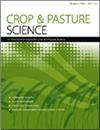在阳光充足和遮荫的条件下,牧场落叶管理目标是否相似?
IF 1.9
4区 农林科学
Q2 AGRICULTURE, MULTIDISCIPLINARY
引用次数: 1
摘要
抽象上下文。适用于在阳光充足的情况下觅食的落叶管理目标尚未针对遮荫环境进行适当评估,例如在有树木的作物-牲畜综合系统中。目的本研究旨在确定在巴西南部和阿根廷牧场系统中广泛使用的耐荫多年生夏草杂交种Axonopus cathinensis(巨型传教士草)在阳光充足和荫蔽环境下的落叶目标。方法。评估了四种落叶前冠层高度(15、25、35和45cm)和四种落叶严重程度(落叶前冠层高降低20%、40%、60%和80%)。植物生长在0.15m3的木箱中,木箱中填充沙子/蛭石基质(1:1 v/v),并用完整的营养液灌溉。用木板条制作了一个人工遮荫结构,使遮荫植物的光照强度降低了50%。关键成果。遮荫植物的牧草积累量比全日照植物减少了54%。无论光照环境如何,当落叶目标高度>35cm时,粗蛋白质含量最低(650g/kg干物质)。当落叶严重程度>落叶前冠层高度的60%时,遮荫和全日照环境的分蘖密度都有所下降。结论。无论光照环境如何,在管理A.cathinensis时,都应避免落叶前冠层高度>35 cm和落叶严重程度>落叶前冠层高的60%。含义。牲畜生产商可以很容易地实现建议的目标,并且在阳光充足和阴凉的环境中也是类似的。本文章由计算机程序翻译,如有差异,请以英文原文为准。
Can pasture defoliation management targets be similar under full sun and shaded conditions?
Abstract Context. Defoliation management targets applied to forages under the full sun have not yet been properly evaluated for shaded environments such as occur in integrated crop–livestock systems with the presence of trees. AimsThis study aimed to determine defoliation targets under full sun and shaded environments for the shade-tolerant perennial summer grass hybrid Axonopus catharinensis (giant missionary grass), widely used in pasture systems of South Brazil and Argentina. Methods. Four pre-defoliation canopy heights (15, 25, 35 and 45 cm) and four defoliation severities (20%, 40%, 60% and 80% reduction in pre-defoliation canopy height) were evaluated. Plants were grown in 0.15 m3 wooden boxes filled with sand/vermiculite substrate (1:1 v/v) and irrigated with a complete nutrient solution. An artificial shade structure was made with wooden slats, reducing light intensity by 50% for shaded plants. Key results. Herbage accumulation decreased by 54% in shaded plants compared with those under full sun. Regardless of the light environment, the lowest crude protein content (<150 g/kg dry matter) and the highest neutral detergent fibre content (>650 g/kg dry matter) were observed when the defoliation target height was >35 cm. Both shaded and full sun environments showed decreases in tiller density when defoliation severity was >60% of pre-defoliation canopy heights. Conclusions. Pre-defoliation canopy heights >35 cm and defoliation severity >60% of pre-defoliation canopy height should be avoided when managing A. catharinensis, regardless of the light environment. Implications. Recommended targets may be easily implemented by livestock producers and are similar for full sun and shade environments.
求助全文
通过发布文献求助,成功后即可免费获取论文全文。
去求助
来源期刊

Crop & Pasture Science
AGRICULTURE, MULTIDISCIPLINARY-
CiteScore
4.20
自引率
15.80%
发文量
111
审稿时长
3 months
期刊介绍:
Crop and Pasture Science (formerly known as Australian Journal of Agricultural Research) is an international journal publishing outcomes of strategic research in crop and pasture sciences and the sustainability of farming systems. The primary focus is broad-scale cereals, grain legumes, oilseeds and pastures. Articles are encouraged that advance understanding in plant-based agricultural systems through the use of well-defined and original aims designed to test a hypothesis, innovative and rigorous experimental design, and strong interpretation. The journal embraces experimental approaches from molecular level to whole systems, and the research must present novel findings and progress the science of agriculture.
Crop and Pasture Science is read by agricultural scientists and plant biologists, industry, administrators, policy-makers, and others with an interest in the challenges and opportunities facing world agricultural production.
Crop and Pasture Science is published with the endorsement of the Commonwealth Scientific and Industrial Research Organisation (CSIRO) and the Australian Academy of Science.
 求助内容:
求助内容: 应助结果提醒方式:
应助结果提醒方式:


